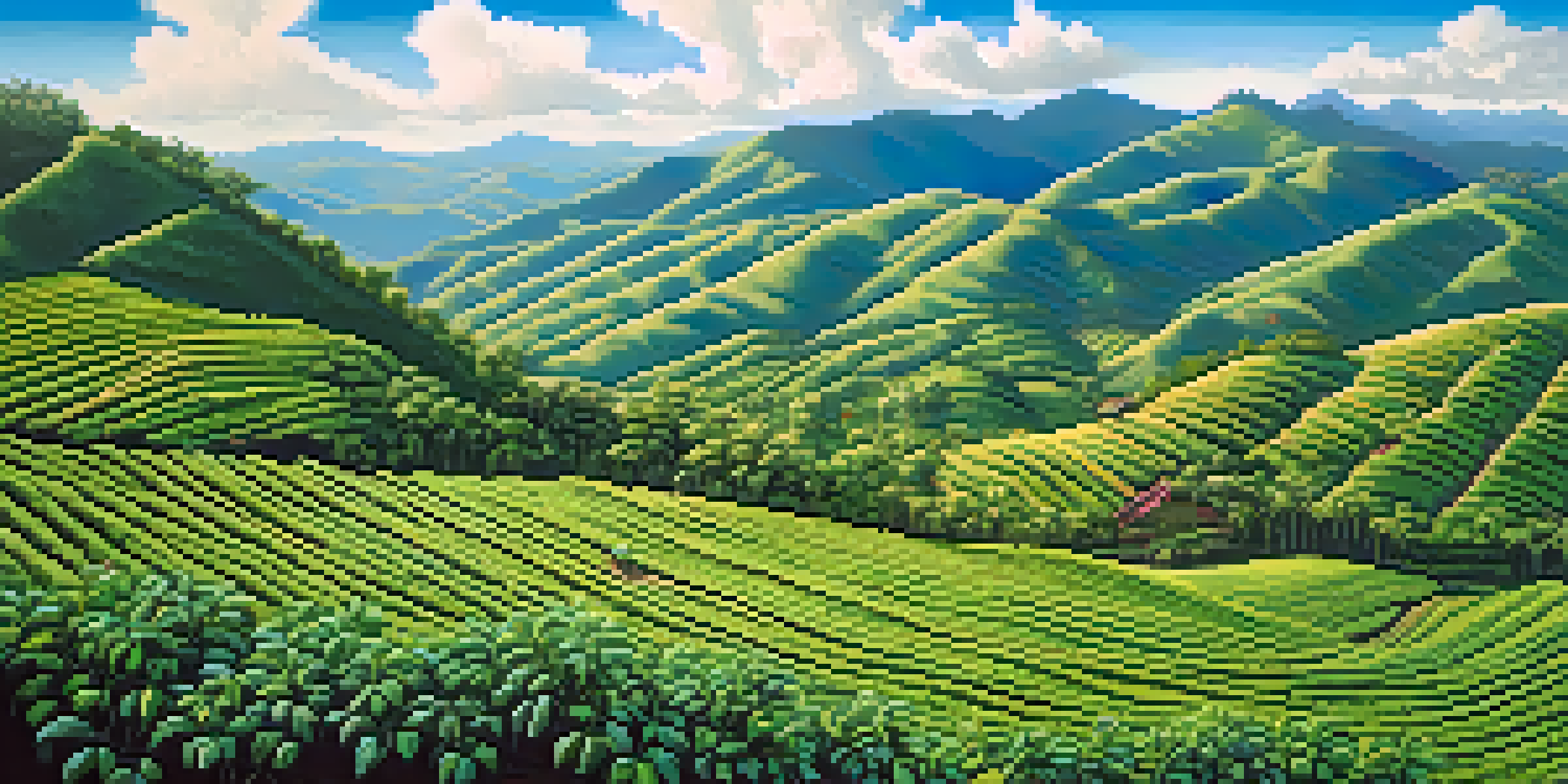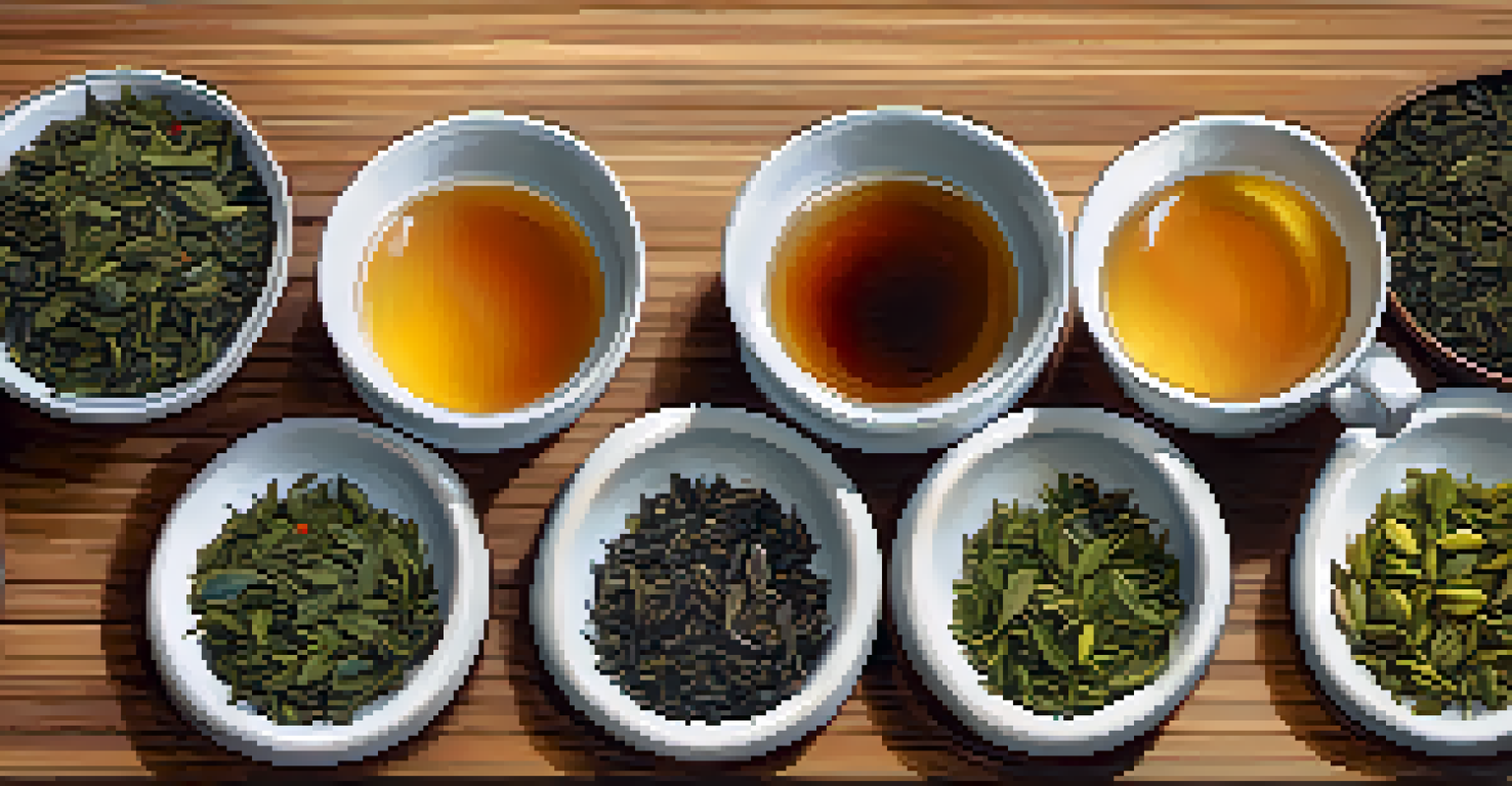The Role of Terroir in Gourmet Coffee and Tea Production

What is Terroir and Why Does It Matter?
Terroir is a French term that refers to the unique environmental factors that affect a crop's characteristics. This includes elements like soil type, climate, elevation, and even local traditions. In the world of gourmet coffee and tea, understanding terroir helps producers cultivate beans and leaves that reflect their specific origins.
Wine is sunlight, held together by water.
Imagine a coffee bean grown in the highlands of Colombia versus one from the coastal regions of Brazil. Each bean absorbs its surroundings, resulting in distinct flavor profiles. Similarly, tea leaves from the misty mountains of Darjeeling will taste dramatically different from those harvested in the sun-drenched fields of Assam.
By appreciating the concept of terroir, consumers can make more informed choices about the coffee and tea they enjoy. This connection to place adds depth to the tasting experience, transforming a simple beverage into a story of its origin.
The Influence of Soil Composition on Flavor Profiles
Soil is a fundamental aspect of terroir that plays a critical role in the flavor of coffee and tea. Different soil types contain various minerals and nutrients that can enhance or alter the taste of the crop. For instance, volcanic soils are often rich in minerals, which can lead to more complex flavors in coffee beans.

Consider the difference between coffee grown in fertile, loamy soil versus sandy, dry soil. The former may produce richer, sweeter beans, while the latter might yield a more acidic flavor. This variation can be subtle, but for connoisseurs, these nuances are what elevate a cup from ordinary to extraordinary.
Terroir Shapes Flavor Profiles
Terroir encompasses environmental factors like soil, climate, and altitude, which significantly influence the unique flavors of coffee and tea.
Similarly, tea grown in mineral-rich soil can develop vibrant, robust flavors, while those cultivated in less nutrient-dense soils may lack depth. Thus, understanding soil composition is essential for producers aiming to create high-quality gourmet beverages.
Climate's Role in Crafting Unique Coffee and Tea
Climate is another vital component of terroir, impacting everything from the growth cycle to the flavor development of coffee and tea. Temperature, rainfall, and sunlight all play roles in how plants grow and what flavors they develop. For example, cooler temperatures can slow down the ripening process of coffee cherries, resulting in a more concentrated flavor.
The best way to find yourself is to lose yourself in the service of others.
In tea production, the timing of monsoon rains can influence the quality of the leaves. A well-timed downpour might lead to a more vibrant green tea, while excessive rain can lead to over-saturation, affecting the leaf's quality. This delicate balance of climate conditions shapes the final product in significant ways.
Producers who understand their local climate can optimize growing conditions to enhance the unique flavors of their coffee and tea. This knowledge ensures that each harvest reflects the best that the environment has to offer.
Altitude and Its Impact on Coffee and Tea Quality
Altitude is a fascinating factor that influences both coffee and tea cultivation. Higher elevations often result in cooler temperatures, which can slow down the growth of coffee cherries and tea leaves. This slower growth allows the plants to develop more complex flavors, leading to a richer tasting experience.
For instance, coffee grown at elevations above 1,200 meters tends to be denser and more flavorful than that grown at sea level. Similarly, tea harvested from high-altitude regions often exhibits a unique aroma and delicate taste that is prized by enthusiasts.
Cultural Practices Enhance Quality
Traditional harvesting and processing methods play a crucial role in developing the distinct characteristics of coffee and tea, showcasing local heritage.
Understanding the relationship between altitude and flavor provides producers with a powerful tool in crafting their products. By selecting optimal growing heights, they can enhance the distinct characteristics of their coffee and tea, making them stand out in the market.
Cultural Practices and Their Effects on Terroir
Cultural practices, including harvesting methods and processing techniques, also play a significant role in shaping the terroir of coffee and tea. Each region has its own traditions and methods that influence the final product. For example, hand-picking coffee cherries is often seen as a way to select only the ripest fruit, ensuring the highest quality.
In tea production, methods like the withering, rolling, and oxidation processes can dramatically alter the flavor profile. For instance, the way oolong tea is oxidized can lead to a wide range of flavors, from floral to fruity, showcasing the significance of cultural practices.
By combining traditional methods with an understanding of terroir, producers can create unique beverages that reflect both their heritage and their environment, offering consumers a taste of place with every sip.
The Connection Between Terroir and Sustainability
Understanding terroir is not just about flavor; it also has implications for sustainability in coffee and tea production. By recognizing the unique characteristics of their environment, producers can adopt practices that enhance the health of their crops while preserving the land. This holistic approach benefits both the growers and the ecosystems they rely on.
For example, farmers who prioritize organic methods often see improvements in soil health and biodiversity, leading to better flavor profiles in their products. Sustainable practices can also help mitigate the effects of climate change, ensuring that future generations can enjoy the same rich flavors.
Sustainability and Terroir Connection
Understanding terroir not only enhances flavor but also promotes sustainable practices that benefit both the environment and crop quality.
Ultimately, a commitment to sustainability goes hand-in-hand with an appreciation of terroir. As consumers become more aware of these connections, they can support brands that prioritize environmentally friendly practices, making a positive impact with every purchase.
Exploring Terroir Through Tasting Experiences
For coffee and tea lovers, experiencing terroir firsthand can be a delightful journey. Many specialty cafes and tea houses offer tastings that allow consumers to explore different varieties from specific regions. This immersive experience highlights the distinct flavors that terroir imparts, making tasting a truly educational adventure.
During these tastings, participants can compare coffees or teas from various terroirs, discovering how subtle differences in soil, climate, and altitude create unique flavor profiles. It’s a chance to engage with the product on a deeper level, transforming the act of drinking into an exploration of geography and culture.

These tasting experiences not only enhance appreciation for the beverages but also foster a greater understanding of the artisans behind them. By connecting consumers with the story of their coffee or tea, we can cultivate a more thoughtful and appreciative audience.